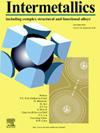Influence of the Ti:Al:Cr proportion on the structure and oxidation resistance of ternary intermetallic coatings produced by non-vacuum electron beam cladding
IF 4.8
2区 材料科学
Q2 CHEMISTRY, PHYSICAL
引用次数: 0
Abstract
Titanium is known to be a material with poor oxidation resistance. When heated, it reacts with atmospheric gases, leading to the formation of the TiO2 oxide film on its surface. This film does not protect the material against further oxidation. To solve this problem, heat-resistant coatings, including TiAl-based ones, are applied to titanium. This study investigates ternary Ti-Al-Cr surface layers with different concentrations of components. The protective layers were fabricated on titanium substrates by non-vacuum electron beam cladding. This method provides the formation of thick coatings (up to 2 mm in a single pass of the electron beam); however, the structure of the cladding layers can be significantly inhomogeneous. To reveal the influence of microstructural features of the coatings and the uneven elemental distribution on their oxidation behavior, detailed structural studies combined with the CALPHAD method were performed both before and after oxidation testing. It was found that an Al-rich alloy consisting primarily of the γ-phase provided the best protection against oxidation. The introduction of high concentrations of both Al and Cr yielded contradictory results. Although the L12-and C14-phases formed in the coating are predicted to contribute to the development of a protective Al2O3 film, the oxidation resistance of this cladding layer was comparable to that of titanium. This result can be attributed to the inhomogeneity of the coating and the appearance of the B2-phase in local areas of the coating at oxidation temperature and the decomposition of the Cr-depleted C14-phase. Furthermore, the Cr-rich B2-phase provides better oxidation resistance than the α2-phase of Al-lean cladding layers.
Ti:Al:Cr比例对非真空电子束熔覆三元金属间膜结构和抗氧化性能的影响
众所周知,钛是一种抗氧化性差的材料。当加热时,它与大气气体发生反应,导致其表面形成TiO2氧化膜。这层薄膜不能防止材料进一步氧化。为了解决这个问题,包括钛基涂层在内的耐热涂层被应用于钛上。本文研究了不同组分浓度的三元Ti-Al-Cr表面层。采用非真空电子束包覆技术在钛基板上制备了保护层。这种方法提供了厚涂层的形成(电子束单次通过可达2毫米);然而,包层的结构可能是明显不均匀的。为了揭示涂层的微观组织特征和元素分布不均匀对其氧化行为的影响,在氧化测试前后结合CALPHAD方法进行了详细的结构研究。结果表明,主要由γ相组成的富al合金具有较好的抗氧化性能。高浓度铝和铬的引入产生了相互矛盾的结果。虽然预测涂层中形成的l12和c14相有助于Al2O3保护膜的形成,但该包层的抗氧化性与钛相当。这一结果可归因于涂层的不均匀性和氧化温度下涂层局部区域b2相的出现以及cr -贫c14相的分解。富cr的b2相比Al-lean熔覆层的α2相具有更好的抗氧化性能。
本文章由计算机程序翻译,如有差异,请以英文原文为准。
求助全文
约1分钟内获得全文
求助全文
来源期刊

Intermetallics
工程技术-材料科学:综合
CiteScore
7.80
自引率
9.10%
发文量
291
审稿时长
37 days
期刊介绍:
This journal is a platform for publishing innovative research and overviews for advancing our understanding of the structure, property, and functionality of complex metallic alloys, including intermetallics, metallic glasses, and high entropy alloys.
The journal reports the science and engineering of metallic materials in the following aspects:
Theories and experiments which address the relationship between property and structure in all length scales.
Physical modeling and numerical simulations which provide a comprehensive understanding of experimental observations.
Stimulated methodologies to characterize the structure and chemistry of materials that correlate the properties.
Technological applications resulting from the understanding of property-structure relationship in materials.
Novel and cutting-edge results warranting rapid communication.
The journal also publishes special issues on selected topics and overviews by invitation only.
 求助内容:
求助内容: 应助结果提醒方式:
应助结果提醒方式:


